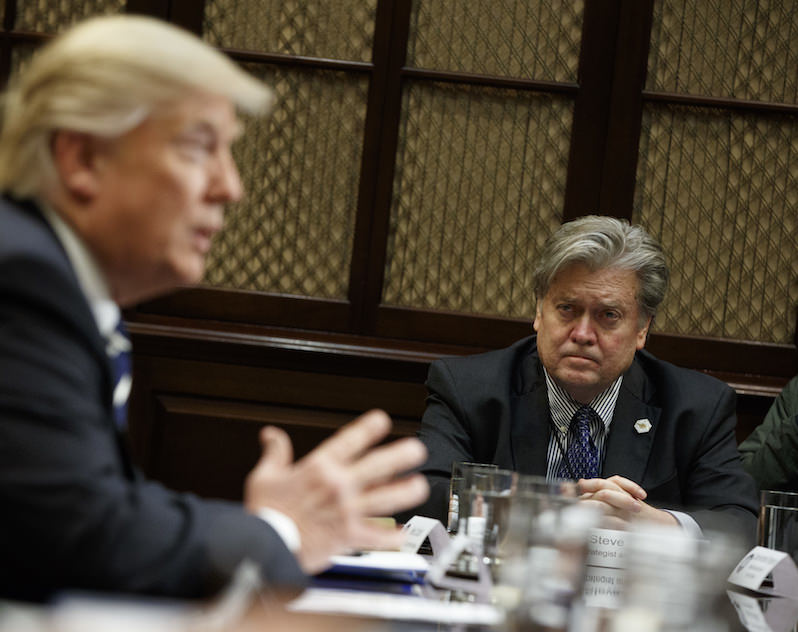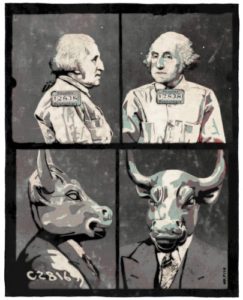Get Used to It, America: Brown People Are Here to Stay
Guided by the xenophobic ideology of such advisers as Steve Bannon, President Trump is pushing back against inevitable changes.
Chief strategist Steve Bannon, right, looms large in Donald Trump’s White House. (Evan Vucci / AP)
There might be a new favorite novel among American conservatives these days. No, it’s not Ayn Rand’s “Atlas Shrugged,” which extolled the virtues of selfishness as a justification for free-market capitalism and once held pride of place on right-wing bookshelves. Rand’s book may well be displaced by one often referred to by White House chief strategist Steve Bannon: “The Camp of the Saints” written in 1973 by French writer Jean Raspail.
Raspail paints a vivid and terrifying picture of white Europeans being overrun by hordes of savage, brown-skinned Indian migrants. In his paranoid and overtly racist novel, liberal sentiments about tolerance and diversity pave the way for territorial takeover. The book, which succumbs to every imaginable ugly stereotype of Indians, has seen a recent resurgence in sales and is favored by white supremacists and an increasing number of conservatives.
Bannon, Donald Trump’s most trusted adviser, seems to fear that Raspail’s xenophobic dystopian vision offers an appropriate warning for the contemporary world. The Huffington Post cites numerous references Bannon has made to the novel over the past few years, most often with respect to Europe’s refugee crisis. For example, in 2015 he said, during an interview with then-Sen. Jeff Sessions, “It’s been almost a ‘Camp of the Saints’-type invasion into Central and then Western and Northern Europe.”
It is hardly a leap to draw links between Bannon’s references to the horrifically racist “Camp of the Saints” and his authorship of Trump’s “Muslim ban.” Bannon clearly fears nonwhite immigrants taking over the spaces inhabited by white Americans. He has said as much, stating in an inaccurate rant that there are too many Asian CEOs in Silicon Valley. Recent attacks on South Asians in the U.S. suggest that this fear is being acted upon by angry, resentful whites.
Bannon’s paranoia is reminiscent of the dark era of American McCarthyism, when fear of communists infiltrating every aspect of American government and society led to witch hunts, baseless accusations and ruined lives. Sen. Joe McCarthy of Wisconsin, who led the aggressive attacks, has been rightly judged by history to be a villain. But Bannon appears to think McCarthy should have been vindicated. In 2013, during an interview with a conservative author Diane West, Bannon said, “The place was infested with either traitors that were on the direct payroll of Soviet military intelligence or fellow-travelers who were kind of compliant in helping these guys get along. I mean, there’s absolutely no question of it.” Referring to McCarthy being seen as a villain today, Bannon asked, “How has pop culture so changed it that white is black and black is white?”
It is highly ironic that in a series of bizarre and baseless rants on Twitter on Saturday, Trump invoked the idea of McCarthyism in claiming President Obama wiretapped his phones. But it is a habit of this administration to depict the opposite of truth as reality.
Bannon’s fear of immigrants taking over the U.S. is reflected in the politics of racial resentment that drove Trump’s election. Whiteness as the default identity of the nation is threatened by demographic shifts toward a browner country, and the backlash has taken the form of President Trump.
But even if Trump succeeds in restricting people from some Muslim-majority nations from entering the U.S., and even if he tries to round up and deport as many undocumented immigrants as possible, it is too late to stop the demographic manifestation of whiteness from shrinking in the U.S. The year 2011 was the first time more nonwhite babies were born in the U.S. compared with white babies, and 2050 is projected to be the year when the nation as a whole will become a “majority minority” state.
This inevitable trend frightens many white Americans. A 2014 psychology study showed as much, reporting that white respondents reacted negatively to ideas of diversity and multiculturalism when presented with graphics of this trend. One reviewer concluded that the study proved that “when white people sense their special status is threatened, it changes how they view politics and the world.” He added, quite presciently, “Certainly worth keeping an eye on as American politics adapt to a changing demographic landscape.”
We may imagine that young whites are more progressive than their elders. It is an often-expressed sentiment that racism in the U.S. will simply die out along with older, white Americans. A look at those who voted for Trump in last November’s election reveals otherwise. Forty-eight percent of white Americans ages 18-29 voted for Trump, compared with 43 percent who voted for Hillary Clinton. Studies confirm that youthfulness among whites does not tame racist sentiments. Bannon, Trump and their ilk are desperately trying to save the sinking ship of white supremacy and are counting on white Americans, young and old, to back them. What they may not have realized is how dependent the U.S. economy is on immigrant labor. According to the U.S. Bureau of Labor Statistics, more than 26 million foreign-born workers contribute to the U.S. economy, which amounts to close to 17 percent of the entire workforce. Nearly half of those workers are listed as “Hispanic,” and about a quarter are Asian. The agency also found that “[f]oreign-born workers were more likely than native-born workers to be employed in service occupations; natural resources, construction, and maintenance occupations; and production, transportation, and material moving occupations.” While foreign-born workers earned, on average, significantly less than their U.S. citizen counterparts, that wage gap closed for workers with higher levels of education.
Foreign-born doctors in particular fill a serious need in the U.S., especially in poor communities. The newly launched Immigrant Doctors Project points out that 7,000 doctors in the U.S. hail from the countries targeted by Trump’s ban. “Cardiology and neurology are two of the three specialties with the highest share of doctors from the six targeted countries,” according to the group’s website. Unless Trump has a plan to promote medical education among native-born Americans, it is unclear who will fill this crucial need if the president has his way.
In taking their highly unethical and unconstitutional actions to preserve whiteness, Trump’s team has unleashed cruelty on the very people it accuses of plotting and enacting violence. But those targeted people won’t back down. In thinking about the petty, jealousy-driven, paranoid rage we face from the Trump administration and its supporters, I am heartened by the sentiment of Elisa Chavez’s powerful poem, “Revenge,” published in the Seattle Review of Books in January. The entire poem is worth reading (out loud if possible), but the lines that stand out most to me are:
We’re the effigies that haunt America’s nights harder the longer they spend burning us, we are scaring the shit out of people by spreading, by refusing to die: what are we but a fire?
If Bannon is worried about a ” ‘Camp of the Saints’-type invasion” of the U.S. by the brown masses, we can only remind him, as Chavez’s poem does (“… you didn’t stop the future from coming. / You just delayed our coronation.”), that he’s too late. We are here, we are not going anywhere, and he’d better get used to it.
Independent journalism is under threat and overshadowed by heavily funded mainstream media.
You can help level the playing field. Become a member.
Your tax-deductible contribution keeps us digging beneath the headlines to give you thought-provoking, investigative reporting and analysis that unearths what's really happening- without compromise.
Give today to support our courageous, independent journalists.






You need to be a supporter to comment.
There are currently no responses to this article.
Be the first to respond.